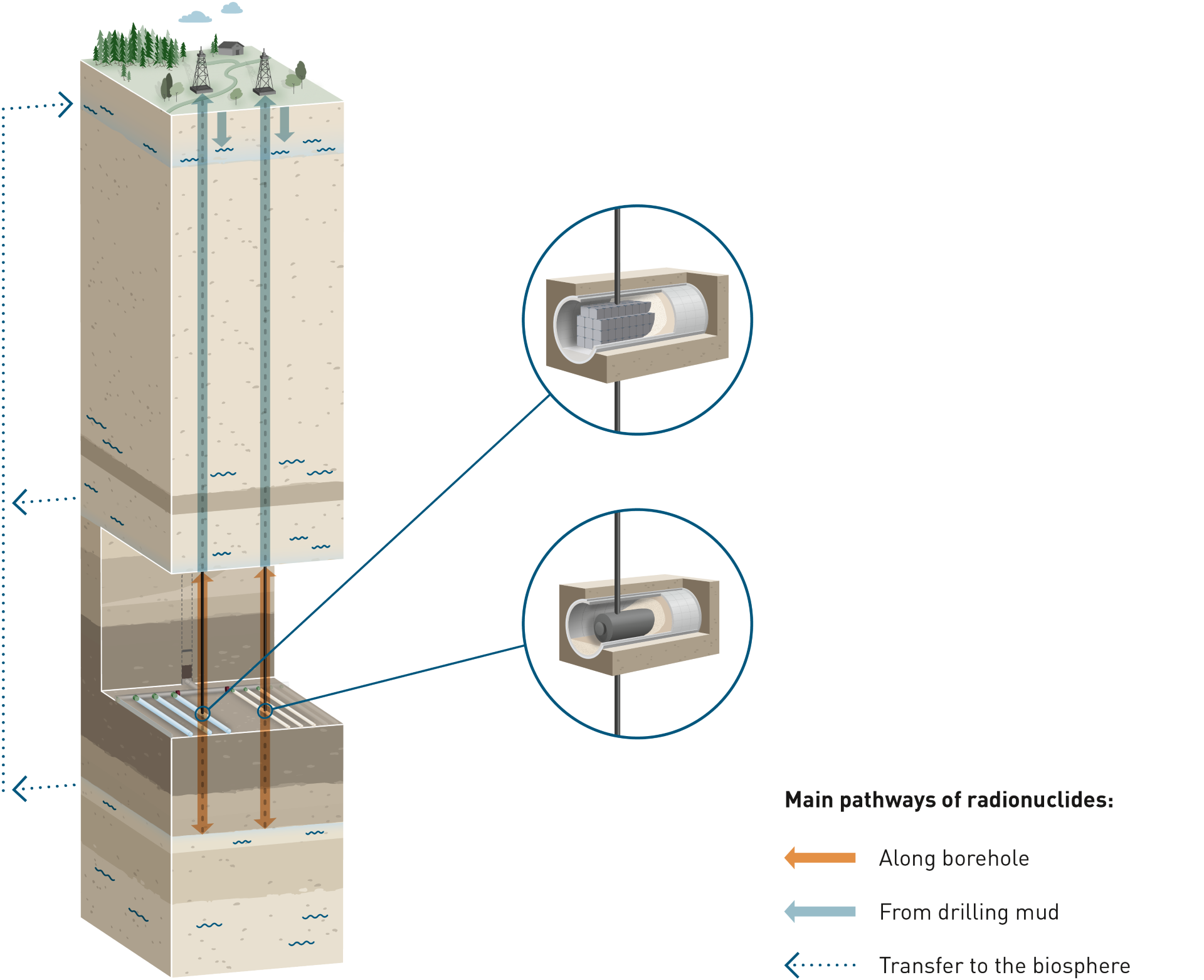The derivation and analysis of future human action (FHA) safety scenarios is described in detail in NAB 24‑09 (Nagra 2024r). Two FHA safety scenarios are formulated and propagated to the analysis of radiological consequences based on a detailed FHA FEP review and discussion.
-
Direct hit by a deep borehole
Drilling a deep borehole is deemed a plausible action at the site that could in principle put humans and the environment at risk. The propagated safety scenario (FHA-1) considers two variants, where the borehole penetrates either an HLW emplacement drift (FHA-1a) or an L/ILW emplacement cavern (FHA-1b), as illustrated in Fig. 7‑8.

Fig. 7‑8:Pathways for radionuclide transport along boreholes in the FHA-1 safety scenario
The borehole safety scenario assumes a continuous borehole through the CRZ and through either the HLW or the L/ILW repository section down into an underlying deep aquifer to allow for advective flow through the borehole. During drilling, contaminated material could be recovered with the drill mud and, with no knowledge of the possible danger, be disposed of in a gravel pit, from where dissolved radionuclides could enter the local biosphere aquifer. Additionally, deep groundwater and radionuclides could migrate through the borehole, which is assumed to remain open and is assigned various flow rates. Both exposure pathways are considered conservatively in a cumulated way.
For the HLW FHA-1 variant, the borehole is assumed to penetrate an SF disposal canister. The calculation case (labelled as FHA-1a-DH-Diss) assesses the subsequent transport of dissolved radionuclides via the aqueous phase. A two-phase flow calculation that accounts for 14C in the form of methane is performed separately for the situation (FHA-1a-DH-Vol).
For L/ILW, the scenario assumes a borehole penetration of an L/ILW emplacement cavern. Three calculation cases are defined to account for the consequences of a waste package hit as well as for the consequences of penetrating a cavern. One calculation case focuses on a direct hit of a single waste package (FHA-1b-WP-Diss), from which contaminated material could be recovered with the drill mud and disposed of in a gravel pit, from where dissolved radionuclides could be transported to the local biosphere aquifer. The other two calculation cases assume that all radionuclides are homogenously distributed within the cavern and could be released via a preferred pathway along the borehole; one case focuses on the aqueous phase (FHA-1b-PFP-Diss), while the other considers two-phase flow with a focus on 14C in the form of methane (FHA-1b-PFP-Vol).
-
Repository abandonment
This FHA safety scenario (FHA-2) addresses the abandonment of the repository during the monitoring phase, when all waste material is below ground but backfilling, sealing and closure of the tunnels and shafts are incomplete. It is assumed that groundwater entry through the open structures accelerates resaturation and leads to enhanced radionuclide transport through the shafts. Both dissolved radionuclides (FHA-2-Diss) and volatile radionuclide (FHA-2-Vol) are considered. The radiological impact is evaluated for the highly soluble, and dose-dominating, radionuclide I-129, and the volatile form (methane) of 14C.

